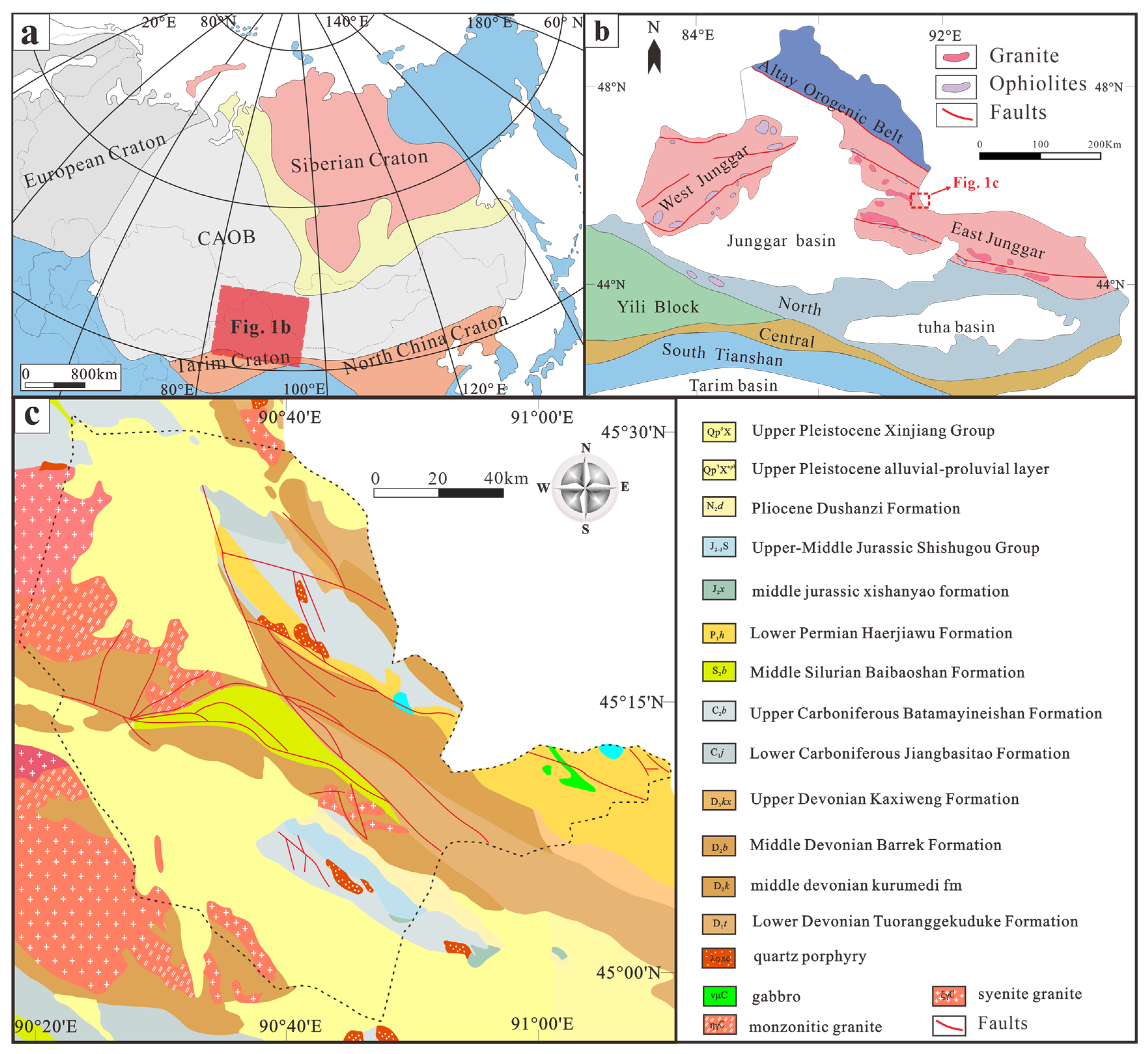Mineralization Alteration Extraction Based on Residual Attention and Hybrid Convolution
Abstract
1. Introduction
2. Regional Geological Background
3. Materials and Methods
3.1. Technical Route
3.2. Data Source and Preprocessing
3.2.1. Selection of Satellite Data
3.2.2. Data Preprocessing
3.3. Spectral Characteristics of Minerals
3.4. Training and Test Sample Generation
3.5. Alteration Information Extraction Network Combining Residual Attention and Hybrid Convolution
3.5.1. Network Structure
3.5.2. Residual Attention
3.5.3. Experimental Environment Design
3.5.4. Evaluation Indicators
4. Result
4.1. Sample Performance
4.2. The Results of Alteration Information Using the RAHC-AIE
4.3. Field Data and Laboratory Analysis
5. Discussion
5.1. Ablation Experiment
5.2. The Relationship Between Extraction Results and Formation Lithology
5.3. Significance of Alteration Ore
6. Conclusions
- (1)
- The model mainly combines the hybrid convolution and residual attention mechanism, and has good robustness in the extraction of alteration information. Compared with other models, the classification accuracy is high, and the recognition effect is remarkable.
- (2)
- According to the distribution of the model extraction results, the field and laboratory verification of hydrothermal alteration was carried out. The laboratory results showed good consistency with the model extraction results.
- (3)
- With further study of the relationship between alteration information and stratigraphic lithology in this area, it is considered that the alteration zone in Beitashan is related to lithology and tectonic action.
Author Contributions
Funding
Data Availability Statement
Conflicts of Interest
References
- Liu, L.; Chen, J.; Li, X.; Zhou, T.; Li, S.; Sun, L.; Huang, L.; Tang, M.; Chen, J. Short wavelength infrared (SWIR) reflectance spectroscopy of alteration minerals of Qibaoshan ore district, Shandong Province, China. Ore Geol. Rev. 2024, 165, 105868. [Google Scholar] [CrossRef]
- Zhou, Y.; Chen, S.; Li, L.; Fan, F.; Zhang, H.; Chen, J.; Yang, K.; Xiu, L.; Xu, M.; Xing, G. Mapping hydrothermal alteration of the Au-Cu deposits in the Zhenghe magmatic-hydrothermal mineralization system, SE China, using Short Wavelength Infrared (SWIR) reflectance spectroscopy. J. Geochem. Explor. 2023, 244, 107113. [Google Scholar] [CrossRef]
- Raza, M.Q.; Absar, N. Mineral chemistry of hydrothermal alteration assemblage in hanging wall Shahapur granite associated with vein-type Gogi uranium deposit, Bhima Basin, Eastern Dharwar Craton, India: Implications for physico-chemical conditions of ore formation. Ore Geol. Rev. 2021, 128, 103880. [Google Scholar] [CrossRef]
- Cooke, D.R.; Deyell, C.L.; Waters, P.J.; Gonzales, R.I.; Zaw, K. Evidence for Magmatic-Hydrothermal Fluids and Ore-Forming Processes in Epithermal and Porphyry Deposits of the Baguio District, Philippines. Econ. Geol. 2011, 106, 1399–1424. [Google Scholar] [CrossRef]
- Shirmard, H.; Farahbakhsh, E.; Pour, A.B.; Muslim, A.M.; Müller, R.D.; Chandra, R. Integration of Selective Dimensionality Reduction Techniques for Mineral Exploration Using ASTER Satellite Data. Remote Sens. 2020, 12, 29. [Google Scholar] [CrossRef]
- Hunt, G.R.; Ashley, R.P. Spectra of altered rocks in the visible and near infrared. Econ. Geol. 1979, 74, 1613–1629. [Google Scholar] [CrossRef]
- Yao, F.; Liu, S.; Wang, D.; Geng, X.; Wang, C.; Jiang, N.; Wang, Y. Review on the development of multi- and hyperspectral remote sensing technology for exploration of copper–gold deposits. Ore Geol. Rev. 2023, 162, 105732. [Google Scholar] [CrossRef]
- Takodjou Wambo, J.D.; Pour, A.B.; Ganno, S.; Asimow, P.D.; Zoheir, B.; Salles, R.d.R.; Nzenti, J.P.; Pradhan, B.; Muslim, A.M. Identifying high potential zones of gold mineralization in a sub-tropical region using Landsat-8 and ASTER remote sensing data: A case study of the Ngoura-Colomines goldfield, eastern Cameroon. Ore Geol. Rev. 2020, 122, 103530. [Google Scholar] [CrossRef]
- Zhang, T.B.; Yi, G.H.; Li, H.M.; Wang, Z.Y.; Tang, J.X.; Zhong, K.H.; Li, Y.B.; Wang, Q.; Bie, X.J. Integrating Data of ASTER and Landsat-8 OLI (AO) for Hydrothermal Alteration Mineral Mapping in Duolong Porphyry Cu-Au Deposit, Tibetan Plateau, China. Remote Sens. 2016, 8, 23. [Google Scholar] [CrossRef]
- Frutuoso, R.; Lima, A.; Teodoro, A.C. Application of remote sensing data in gold exploration: Targeting hydrothermal alteration using Landsat 8 imagery in northern Portugal. Arab. J. Geosci. 2021, 14, 459. [Google Scholar] [CrossRef]
- Ye, B.; Tian, S.F.; Ge, J.; Sun, Y.Q. Assessment of WorldView-3 Data for Lithological Mapping. Remote Sens. 2017, 9, 19. [Google Scholar] [CrossRef]
- Kruse, F.A.; Perry, S.L. Mineral Mapping Using Simulated Worldview-3 Short-Wave-Infrared Imagery. Remote Sens. 2013, 5, 2688–2703. [Google Scholar] [CrossRef]
- Wang, R.; Xiong, S.; Nie, H.; Liang, S.; Qi, Z.; Yang, J.; Yan, B.; Zhao, F.; Fan, J.; Tong, L.; et al. Remote Sensing Technology and its Application in Geological Exploration. Dizhi Xuebao 2011, 85, 1699–1743. [Google Scholar]
- Zhang, X.L.; Zhao, Z.F.; Chen, Q.; Chai, W.; Li, Z.Y.; Zhang, G.; Yang, H.Y.; Niu, L. Mapping hydrothermal alteration of the Pulang porphyry copper deposit, SW China, using ASTER and ZY1-02D satellite data. Ore Geol. Rev. 2023, 161, 16. [Google Scholar] [CrossRef]
- Fu, H.; Cheng, Q.; Jing, L.; Ge, Y. Deep learning-based hydrothermal alteration mapping using GaoFen-5 hyperspectral data in the Duolong Ore District, Western Tibet, China. J. Appl. Remote Sens. 2021, 15, 044512. [Google Scholar] [CrossRef]
- Cracknell, M.J.; Reading, A.M. Geological mapping using remote sensing data: A comparison of five machine learning algorithms, their response to variations in the spatial distribution of training data and the use of explicit spatial information. Comput. Geosci. 2014, 63, 22–33. [Google Scholar] [CrossRef]
- He, J.; Harris, J.R.; Sawada, M.; Behnia, P. A comparison of classification algorithms using Landsat-7 and Landsat-8 data for mapping lithology in Canada’s Arctic. Int. J. Remote Sens. 2015, 36, 2252–2276. [Google Scholar] [CrossRef]
- Hu, B.; Wan, B.; Xu, Y.; Tao, L.; Wu, X.; Qiu, Q.; Wu, Y.; Deng, H. Mapping hydrothermally altered minerals with AST_07XT, AST_05 and Hyperion datasets using a voting-based extreme learning machine algorithm. Ore Geol. Rev. 2019, 114, 103116. [Google Scholar] [CrossRef]
- Shirmard, H.; Farahbakhsh, E.; Müller, R.D.; Chandra, R. A review of machine learning in processing remote sensing data for mineral exploration. Remote Sens. Environ. 2022, 268, 112750. [Google Scholar] [CrossRef]
- Zhang, C.; Zuo, R.; Xiong, Y. Detection of the multivariate geochemical anomalies associated with mineralization using a deep convolutional neural network and a pixel-pair feature method. Appl. Geochem. 2021, 130, 104994. [Google Scholar] [CrossRef]
- Dong, Y.; Yang, Z.; Liu, Q.; Zuo, R.; Wang, Z. Fusion of GaoFen-5 and Sentinel-2B data for lithological mapping using vision transformer dynamic graph convolutional network. Int. J. Appl. Earth Obs. Geoinf. 2024, 129, 103780. [Google Scholar] [CrossRef]
- Hinton, G.E.; Salakhutdinov, R.R. Reducing the dimensionality of data with neural networks. Science 2006, 313, 504–507. [Google Scholar] [CrossRef] [PubMed]
- Song, H.; Kim, Y.; Kim, Y. A Patch-Based Light Convolutional Neural Network for Land-Cover Mapping Using Landsat-8 Images. Remote Sens. 2019, 11, 19. [Google Scholar] [CrossRef]
- Mahdianpari, M.; Salehi, B.; Rezaee, M.; Mohammadimanesh, F.; Zhang, Y. Very Deep Convolutional Neural Networks for Complex Land Cover Mapping Using Multispectral Remote Sensing Imagery. Remote Sens. 2018, 10, 21. [Google Scholar] [CrossRef]
- Kroupi, E.; Kesa, M.; Navarro-Sánchez, V.D.; Saeed, S.; Pelloquin, C.; Alhaddad, B.; Moreno, L.; Soria-Frisch, A.; Ruffini, G. Deep convolutional neural networks for land-cover classification with Sentinel-2 images. J. Appl. Remote Sens. 2019, 13, 22. [Google Scholar] [CrossRef]
- Liu, C.; Wang, W.; Tang, J.; Wang, Q.; Zheng, K.; Sun, Y.; Zhang, J.; Gan, F.; Cao, B. A deep-learning-based mineral prospectivity modeling framework and workflow in prediction of porphyry–epithermal mineralization in the Duolong ore District, Tibet. Ore Geol. Rev. 2023, 157, 105419. [Google Scholar] [CrossRef]
- Wang, Z.; Zuo, R. Mineral prospectivity mapping using a joint singularity-based weighting method and long short-term memory network. Comput. Geosci. 2022, 158, 104974. [Google Scholar] [CrossRef]
- Xiong, Y.; Zuo, R.; Carranza, E.J.M. Mapping mineral prospectivity through big data analytics and a deep learning algorithm. Ore Geol. Rev. 2018, 102, 811–817. [Google Scholar] [CrossRef]
- Zidan, U.; El Desouky, H.A.; Gaber, M.M.; Abdelsamea, M.M. From Pixels to Deposits: Porphyry Mineralization With Multispectral Convolutional Neural Networks. IEEE J. Sel. Top. Appl. Earth Observ. Remote Sens. 2023, 16, 9474–9486. [Google Scholar] [CrossRef]
- Jiang, X.; Liu, Q.; Yan, L.; Cao, X.; Chen, Y.; Wei, Y.; Wang, F.; Xing, H. Hyperspectral imaging combined with Spectral-Imagery Feature Fusion Convolutional Neural Network to discriminate different geographical origins of wolfberries. J. Food Compos. Anal. 2024, 132, 106259. [Google Scholar] [CrossRef]
- Lv, H.; Li, Y.; Zhang, H.; Wang, R. Multi-dimensional deep dense residual networks and multiple kernel learning for hyperspectral image classification. Infrared Phys. Technol. 2024, 138, 105265. [Google Scholar] [CrossRef]
- Song, Y.; Zhang, Z.; Baghbaderani, R.K.; Wang, F.; Qu, Y.; Stuttsy, C.; Qi, H. Land cover classification for satellite images through 1D CNN. In Proceedings of the 2019 10th Workshop on Hyperspectral Imaging and Signal Processing: Evolution in Remote Sensing (WHISPERS), Amsterdam, The Netherlands, 24–26 September 2019; pp. 1–5. [Google Scholar]
- Xu, X.; Li, W.; Ran, Q.; Du, Q.; Gao, L.; Zhang, B. Multisource remote sensing data classification based on convolutional neural network. IEEE Trans. Geosci. Remote Sens. 2017, 56, 937–949. [Google Scholar] [CrossRef]
- Zhong, Z.; Li, J.; Luo, Z.; Chapman, M. Spectral–spatial residual network for hyperspectral image classification: A 3-D deep learning framework. IEEE Trans. Geosci. Remote Sens. 2017, 56, 847–858. [Google Scholar] [CrossRef]
- Khain, E.V.; Bibikova, E.V.; Kröner, A.; Zhuravlev, D.Z.; Sklyarov, E.; Fedotova, A.A.; Kravchenko-Berezhnoy, I.R. The most ancient ophiolite of the Central Asian fold belt:: U-Pb and Pb-Pb zircon ages for the Dunzhugur Complex, Eastern Sayan, Siberia, and geodynamic implications. Earth Planet. Sci. Lett. 2002, 199, 311–325. [Google Scholar] [CrossRef]
- Jahn, B.-M. The Central Asian Orogenic Belt and growth of the continental crust in the Phanerozoic. Asp. Tecton. Evol. China 2004, 226, 73–100. [Google Scholar] [CrossRef]
- Wang, Z.; Zhang, J.; Wu, C.; Qu, J.; Zhang, B.; Zhao, H.; Zhang, Y.; Yang, Y. A uniform basement: Implications for the tectonics of Beishan Orogenic Belt in the southern Central Asian Orogenic Belt. Precambrian Res. 2024, 404, 107340. [Google Scholar] [CrossRef]
- Xu, Q.; Zhao, L.; Niu, B.; Zheng, R.; Yang, Y.; Liu, J. Early Paleozoic arc magmatism in the Kalamaili orogenic belt, Northern Xinjiang, NW China: Implications for the tectonic evolution of the East Junggar terrane. J. Asian Earth Sci. 2020, 194, 104072. [Google Scholar] [CrossRef]
- Yang, F.; Geng, X.; Zhang, Z.; Liu, G.; Zhang, H. A review of the geological characteristics and spatiotemporal distribution of copper–gold deposits in the Central Asian Orogenic Belt, Xinjiang, Northwest China. J. Asian Earth Sci. 2024, 259, 105899. [Google Scholar] [CrossRef]
- Cheng, Q.M.; Jing, L.H.; Panahi, A. Principal component analysis with optimum order sample correlation coefficient for image enhancement. Int. J. Remote Sens. 2006, 27, 3387–3401. [Google Scholar] [CrossRef]
- Xiao, W.; Han, C.; Yuan, C.; Sun, M.; Lin, S.; Chen, H.; Li, Z.; Li, J.; Sun, S. Middle Cambrian to Permian subduction-related accretionary orogenesis of Northern Xinjiang, NW China: Implications for the tectonic evolution of central Asia. J. Asian Earth Sci. 2008, 32, 102–117. [Google Scholar] [CrossRef]
- Xiao, W.; Windley, B.F.; Badarch, G.; Sun, S.; Li, J.; Qin, K.; Wang, Z. Palaeozoic accretionary and convergent tectonics of the southern Altaids: Implications for the growth of Central Asia. J. Geol. Soc. 2004, 161, 339–342. [Google Scholar] [CrossRef]
- Xiao, Y.; Zhang, H.F.; Shi, J.A.; Su, B.X.; Sakyi, P.A.; Lu, X.C.; Hu, Y.; Zhang, Z. Late Paleozoic magmatic record of East Junggar, NW China and its significance: Implication from zircon U-Pb dating and Hf isotope. Gondwana Res. 2011, 20, 532–542. [Google Scholar] [CrossRef]
- Han, B.F.; Ji, J.Q.; Song, B.; Chen, L.H.; Zhang, L. Late Paleozoic vertical growth of continental crust around the Junggar Basin, Xinjiang, China (Part I): Timing of post-collisional plutonism. Acta Petrol. Sin. 2006, 22, 1077–1086. [Google Scholar]
- Li, X.; Chen, G.; Wu, C.; Li, J.; Haproff, P.J.; Geng, M.; Wu, S.; Xu, S.; Li, Z.; Yang, D. Tectono-stratigraphic framework and evolution of East Junggar Basin, Central Asia. Tectonophysics 2023, 851, 229758. [Google Scholar] [CrossRef]
- Zhang, L.; He, D.; Yi, Z.; Li, D. Tectonic relationship between the Kelameili range and the Dajing depression: Insights into the Carboniferous tectonic-sedimentary framework. Pet. Explor. Dev. 2020, 47, 30–45. [Google Scholar] [CrossRef]
- Chen, H.; Wan, B.; Pirajno, F.; Chen, Y.; Xiao, B. Metallogenesis of the Xinjiang Orogens, NW China—New discoveries and ore genesis. Ore Geol. Rev. 2018, 100, 1–11. [Google Scholar] [CrossRef]
- Gao, F.; Pei, X.; Cheng, Y.; Guo, R.; Sun, C.; Liu, X.; Li, Z.; Chen, Y.; Wang, M.; Liu, Z. Petrogenesis of the early Permian A-type granites in eastern North Tianshan, Central Asian Orogenic Belt: Implications for the final geodynamic evolution of the Kalamaili suture zone. J. Asian Earth Sci. 2024, 264, 106057. [Google Scholar] [CrossRef]
- Li, Q.; Lü, S.; Yang, F.; Geng, X.; Chai, F. Geological characteristics and genesis of the Laoshankou Fe–Cu–Au deposit in Junggar, Xinjiang, Central Asian Orogenic Belt. Ore Geol. Rev. 2015, 68, 59–78. [Google Scholar] [CrossRef]
- Xu, Q.-Q.; Ji, J.-Q.; Zhao, L.; Gong, J.-F.; Zhou, J.; He, G.-Q.; Zhong, D.-L.; Wang, J.-D.; Griffiths, L. Tectonic evolution and continental crust growth of Northern Xinjiang in northwestern China: Remnant ocean model. Earth-Sci. Rev. 2013, 126, 178–205. [Google Scholar] [CrossRef]
- Roy, D.P.; Wulder, M.A.; Loveland, T.R.; Woodcock, C.E.; Allen, R.G.; Anderson, M.C.; Helder, D.; Irons, J.R.; Johnson, D.M.; Kennedy, R.; et al. Landsat-8: Science and product vision for terrestrial global change research. Remote Sens. Environ. 2014, 145, 154–172. [Google Scholar] [CrossRef]
- Bahrami, H.; Esmaeili, P.; Homayouni, S.; Pour, A.B.; Chokmani, K.; Bahroudi, A. Machine Learning-Based Lithological Mapping from ASTER Remote-Sensing Imagery. Minerals 2024, 14, 27. [Google Scholar] [CrossRef]
- Sun, Y.; Tian, S.; Di, B. Extracting mineral alteration information using WorldView-3 data. Geosci. Front. 2017, 8, 1051–1062. [Google Scholar] [CrossRef]
- Vaswani, A.; Shazeer, N.; Parmar, N.; Uszkoreit, J.; Jones, L.; Gomez, A.N.; Kaiser, L.; Polosukhin, I. Attention Is All You Need. In Proceedings of the 31st Annual Conference on Neural Information Processing Systems (NIPS), Long Beach, CA, USA, 4–9 December 2017. [Google Scholar]
- Xi, M.F.; Li, J.; He, Z.L.; Yu, M.M.; Qin, F. NRN-RSSEG: A Deep Neural Network Model for Combating Label Noise in Semantic Segmentation of Remote Sensing Images. Remote Sens. 2023, 15, 18. [Google Scholar] [CrossRef]
- Xue, C.J.; Chi, G.X.; Zhao, X.B.; Wu, G.G.; Zhao, Z.F.; Dong, L.H. Multiple and prolonged porphyry Cu-Au mineralization and alteration events in the Halasu deposit, Chinese Altai, Xinjiang, northwestern China. Geosci. Front. 2016, 7, 799–809. [Google Scholar] [CrossRef][Green Version]
- Liang, P.; Chen, H.Y.; Hollings, P.; Xiao, B.; Wu, C.; Bao, Z.W.; Cai, K.D. The Paleozoic tectonic evolution and metallogenesis of the northern margin of East Junggar, Central Asia Orogenic Belt: Geochronological and geochemical constraints from igneous rocks of the Qiaoxiahala Fe-Cu deposit. J. Asian Earth Sci. 2016, 130, 23–45. [Google Scholar] [CrossRef]
- Han, C.M.; Mao, W.J.; Zhao, G.C.; Qu, W.J.; Du, A.D. Re-Os dating of the Kalatongke Cu-Ni deposit, Altay Shan, NW China, and resulting geodynamic implications. Ore Geol. Rev. 2007, 32, 452–468. [Google Scholar] [CrossRef]
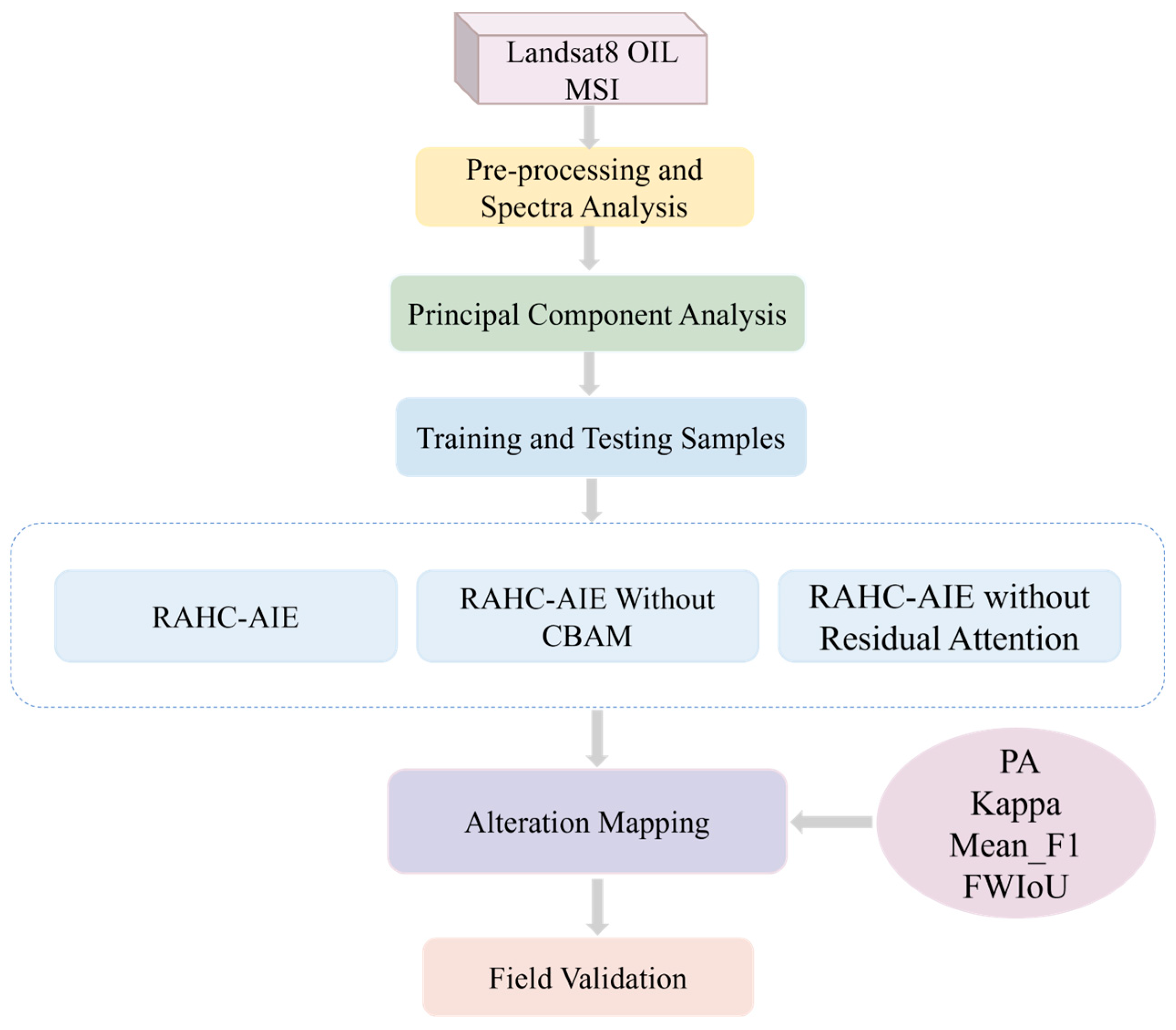

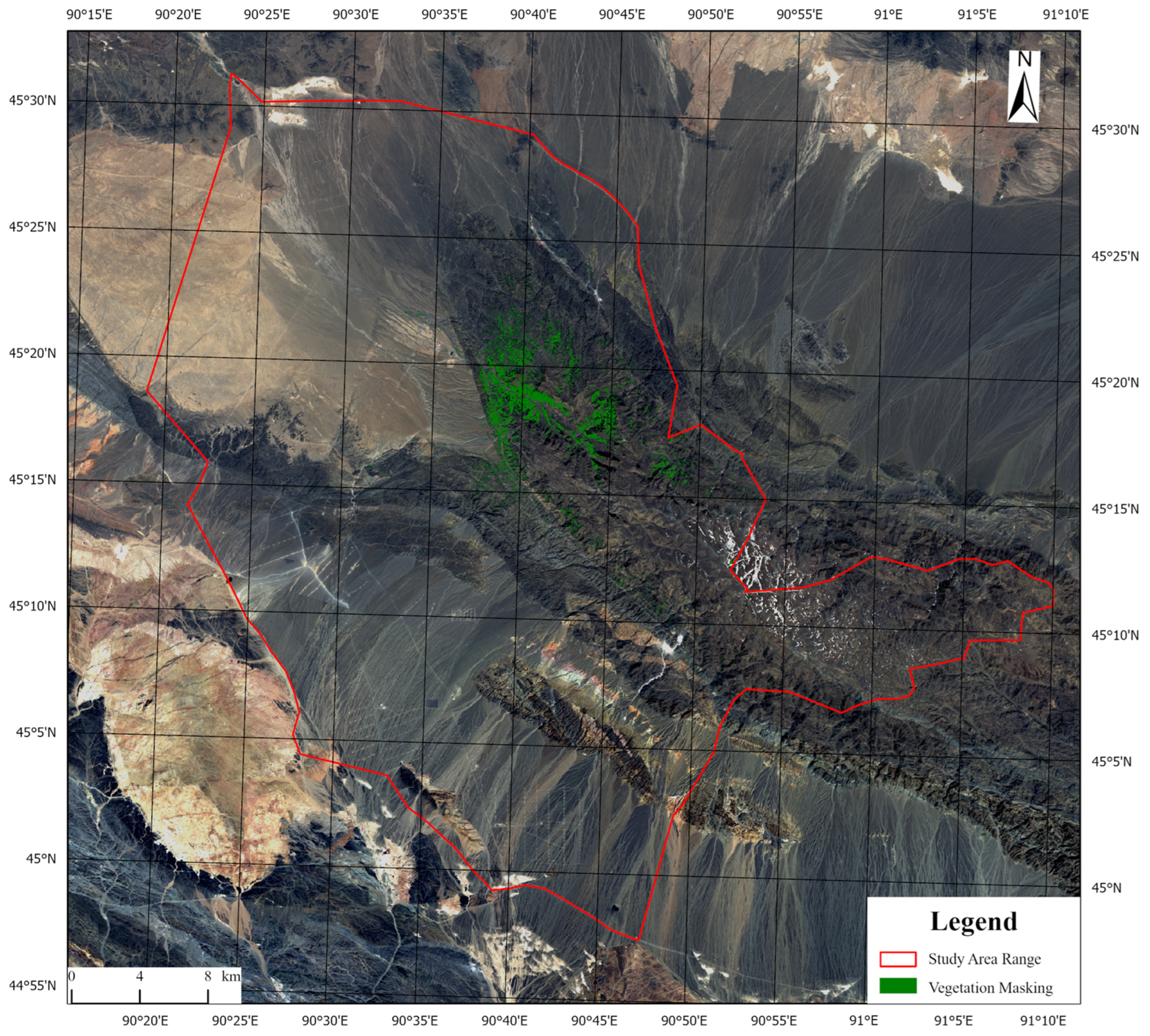
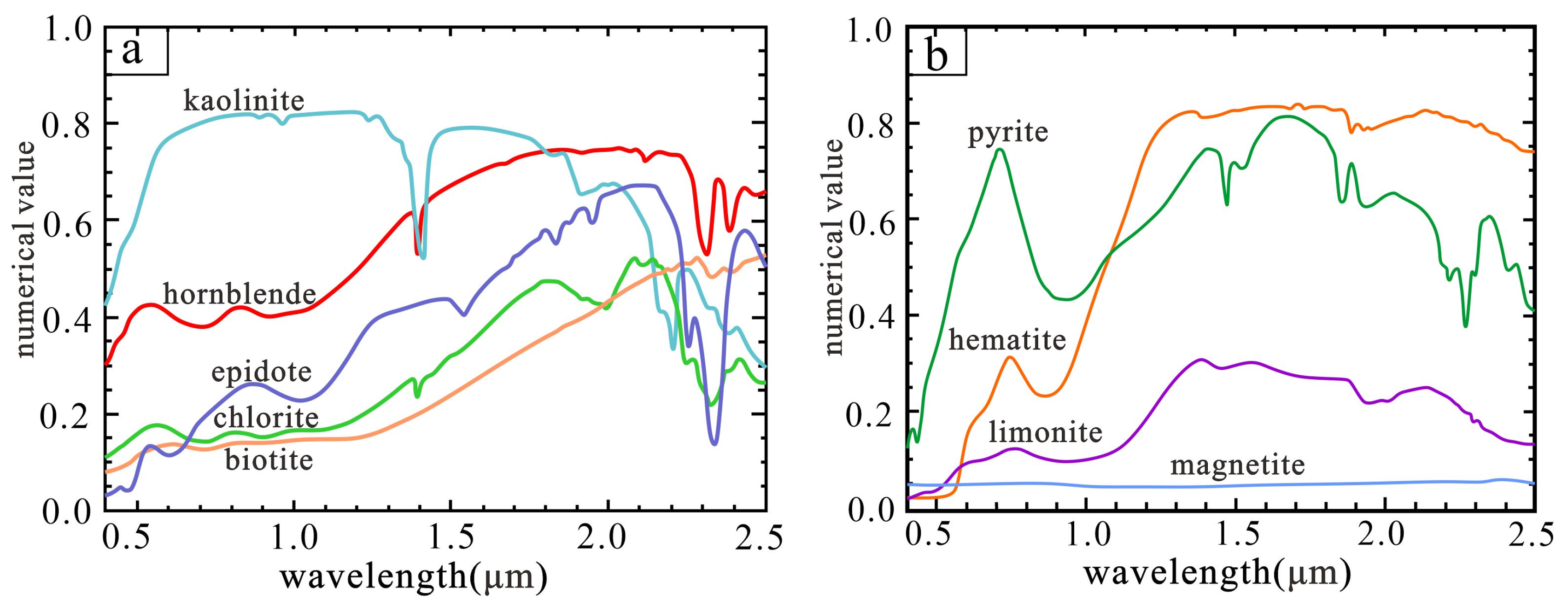
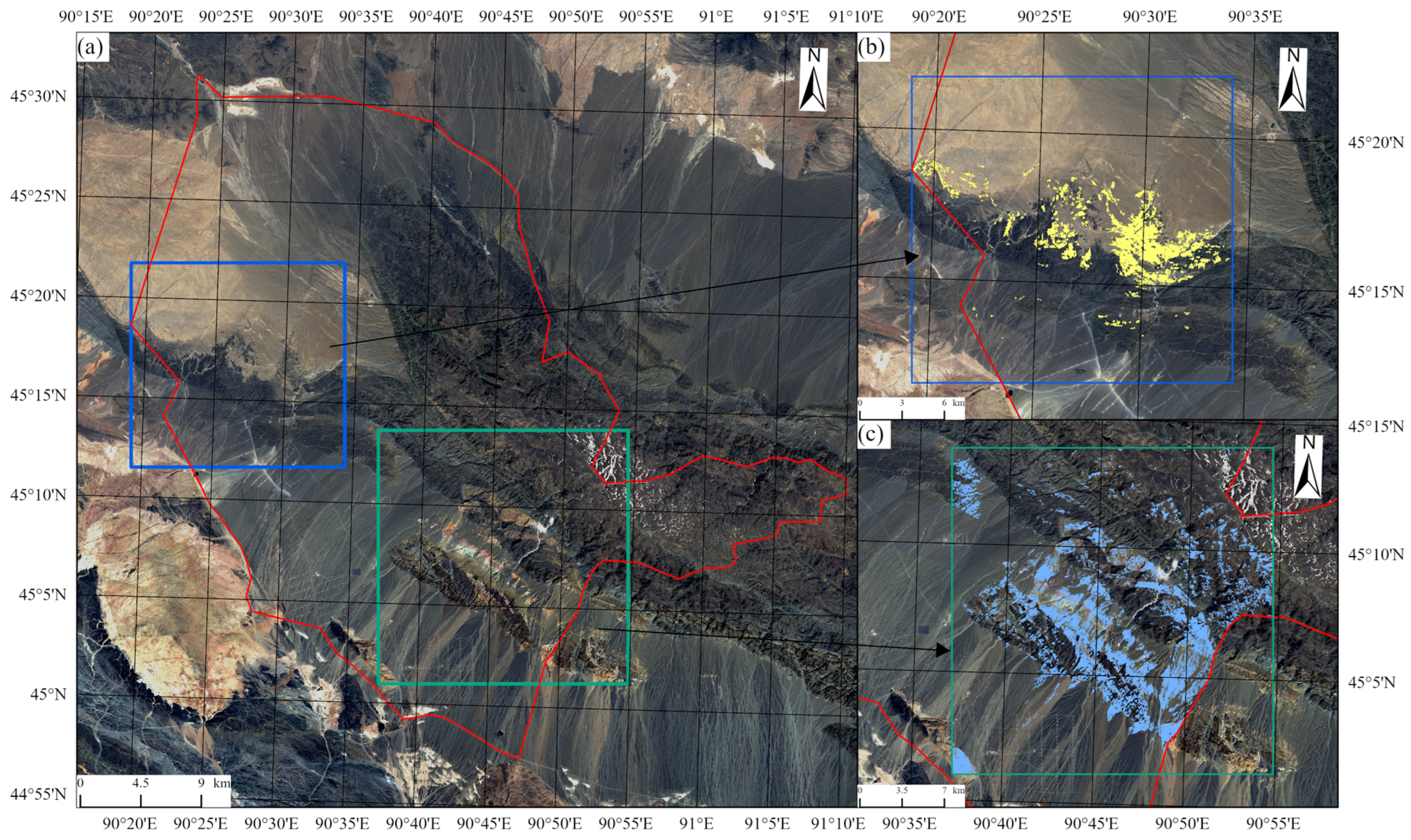
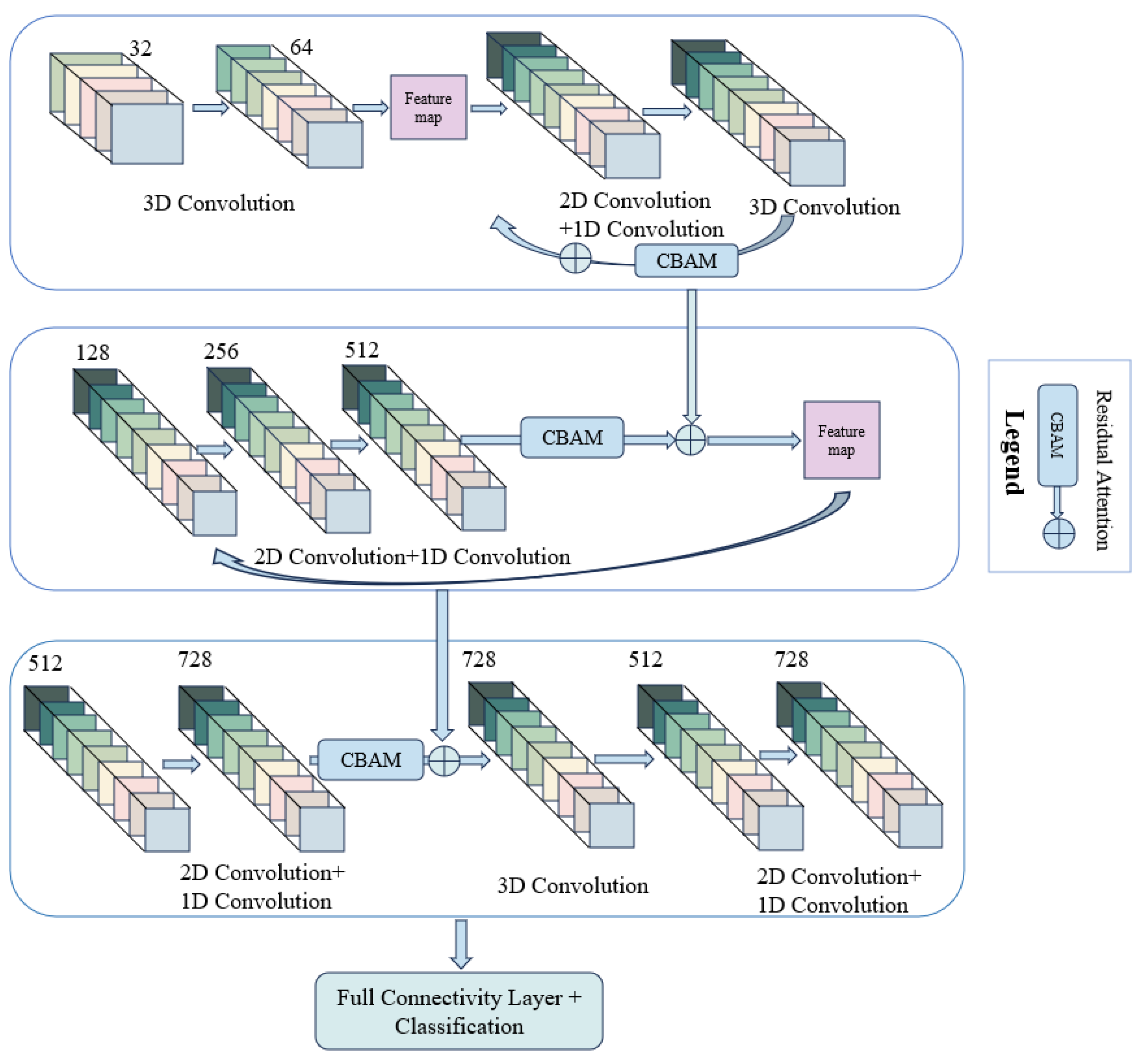

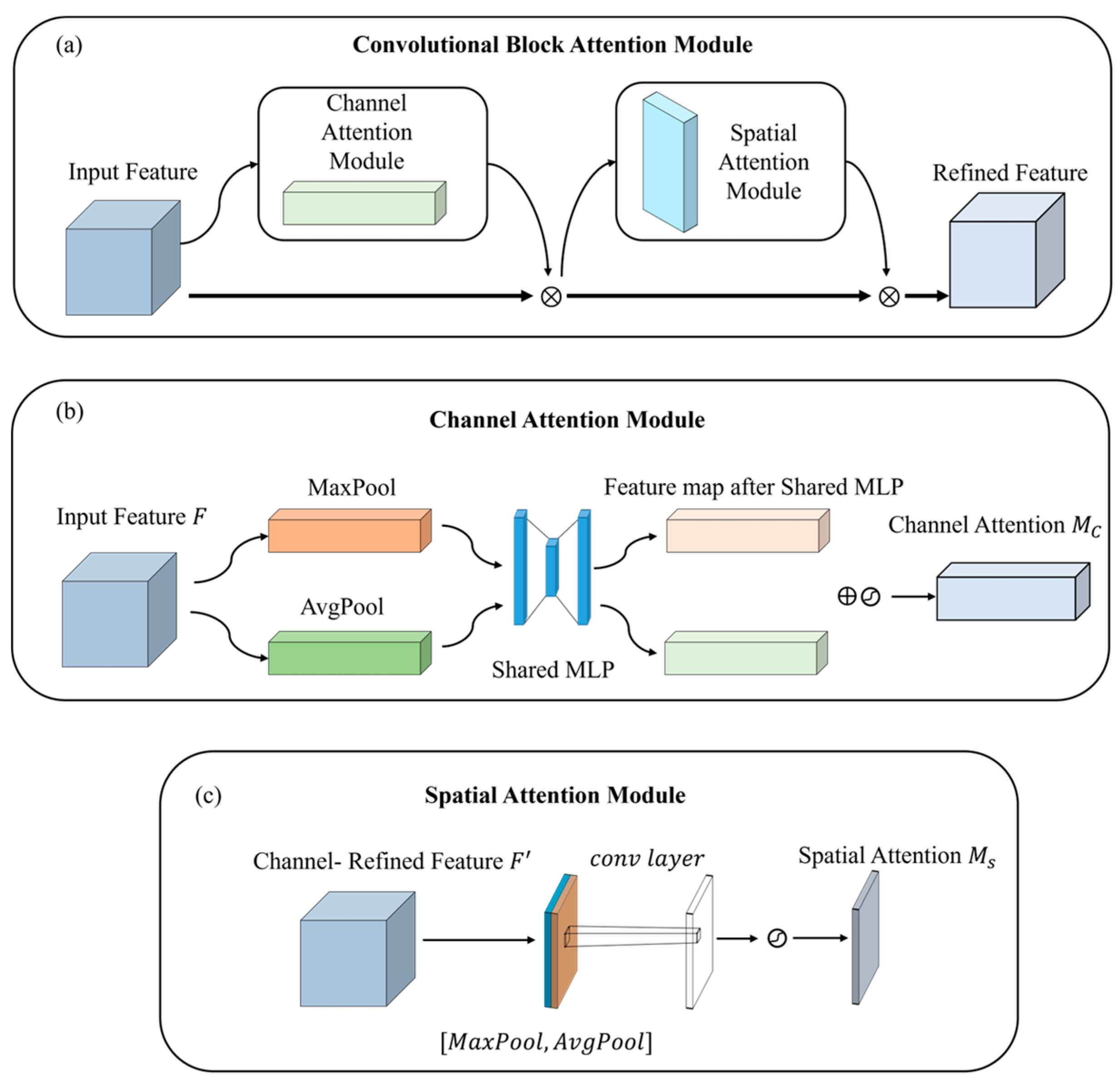
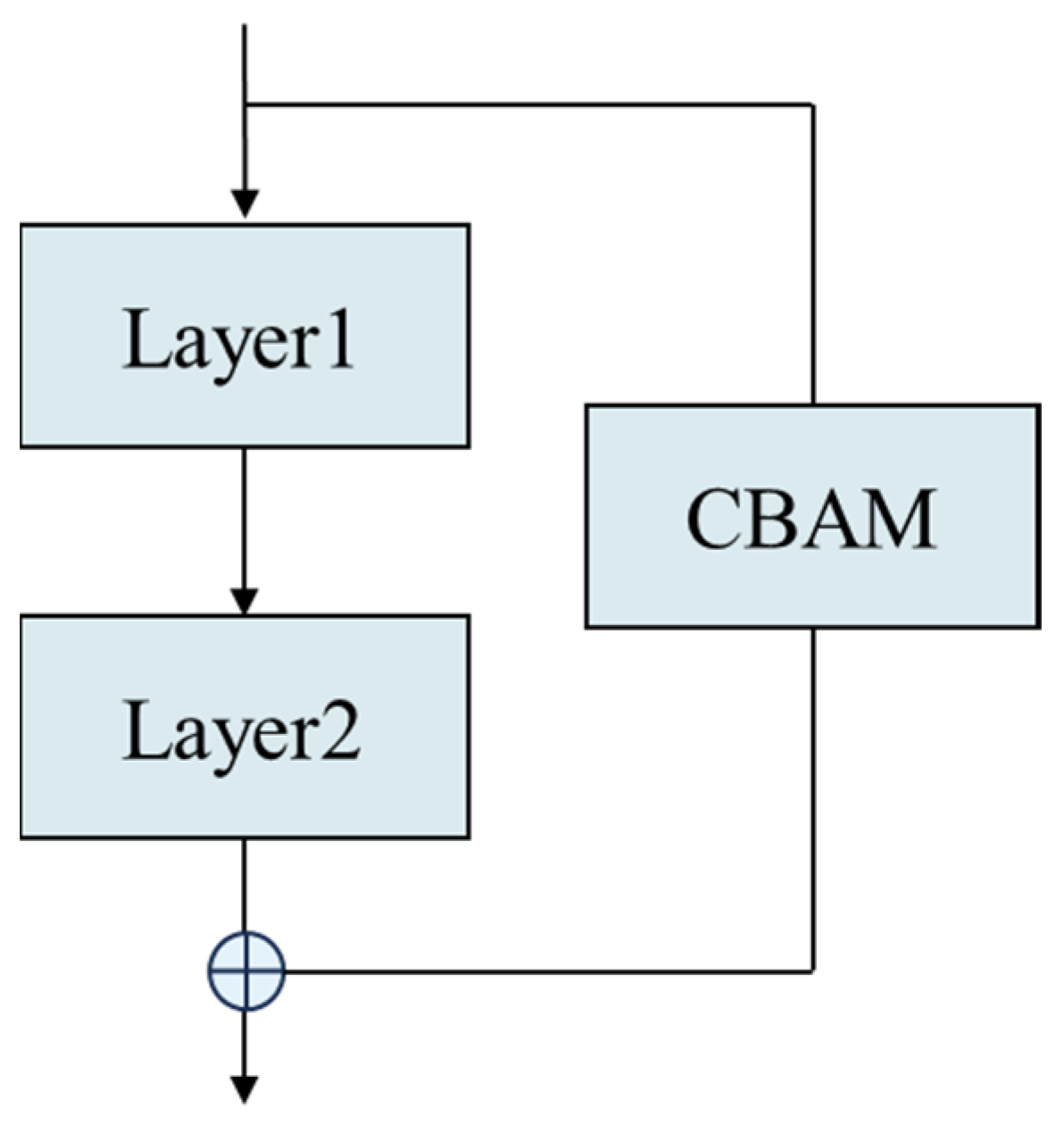

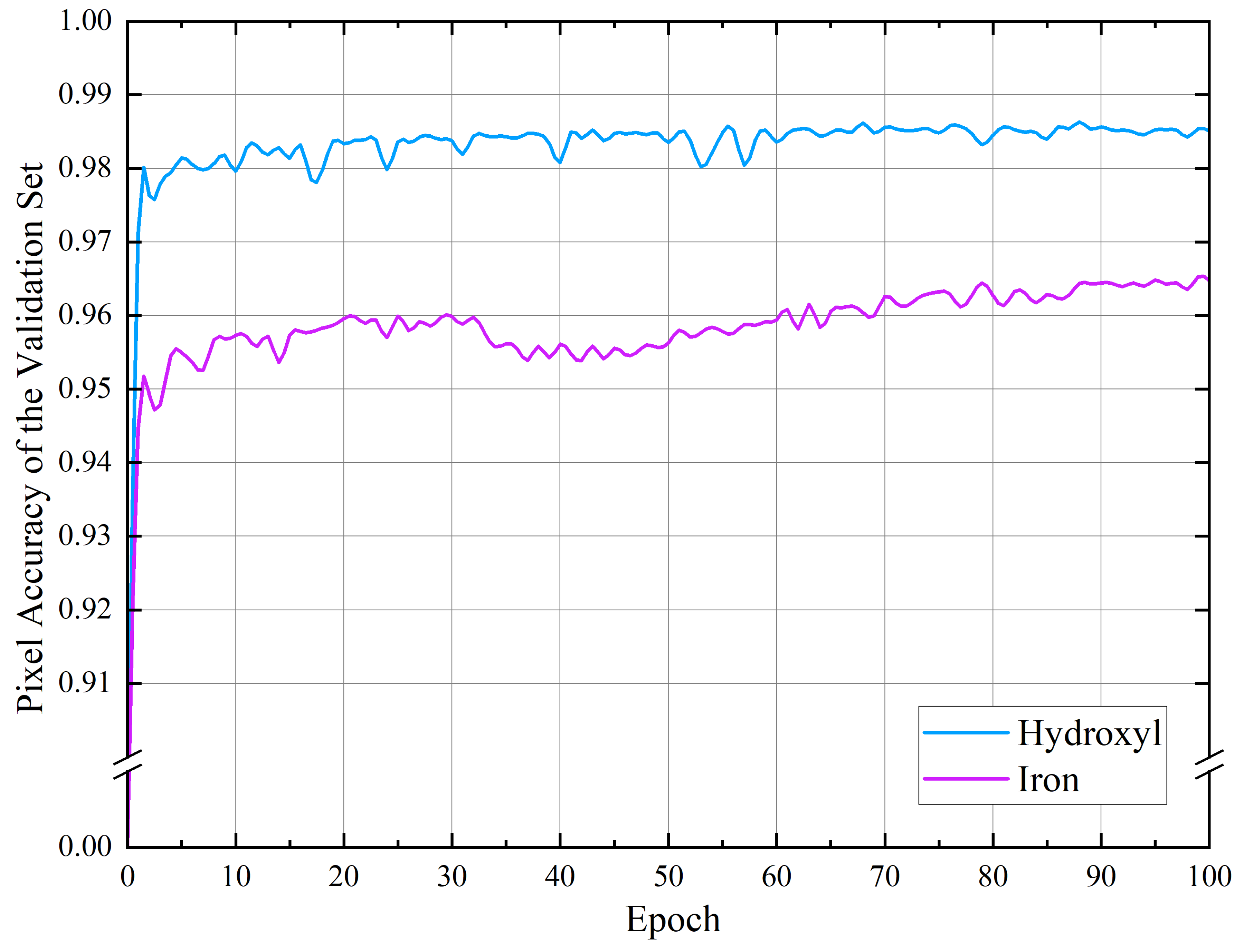
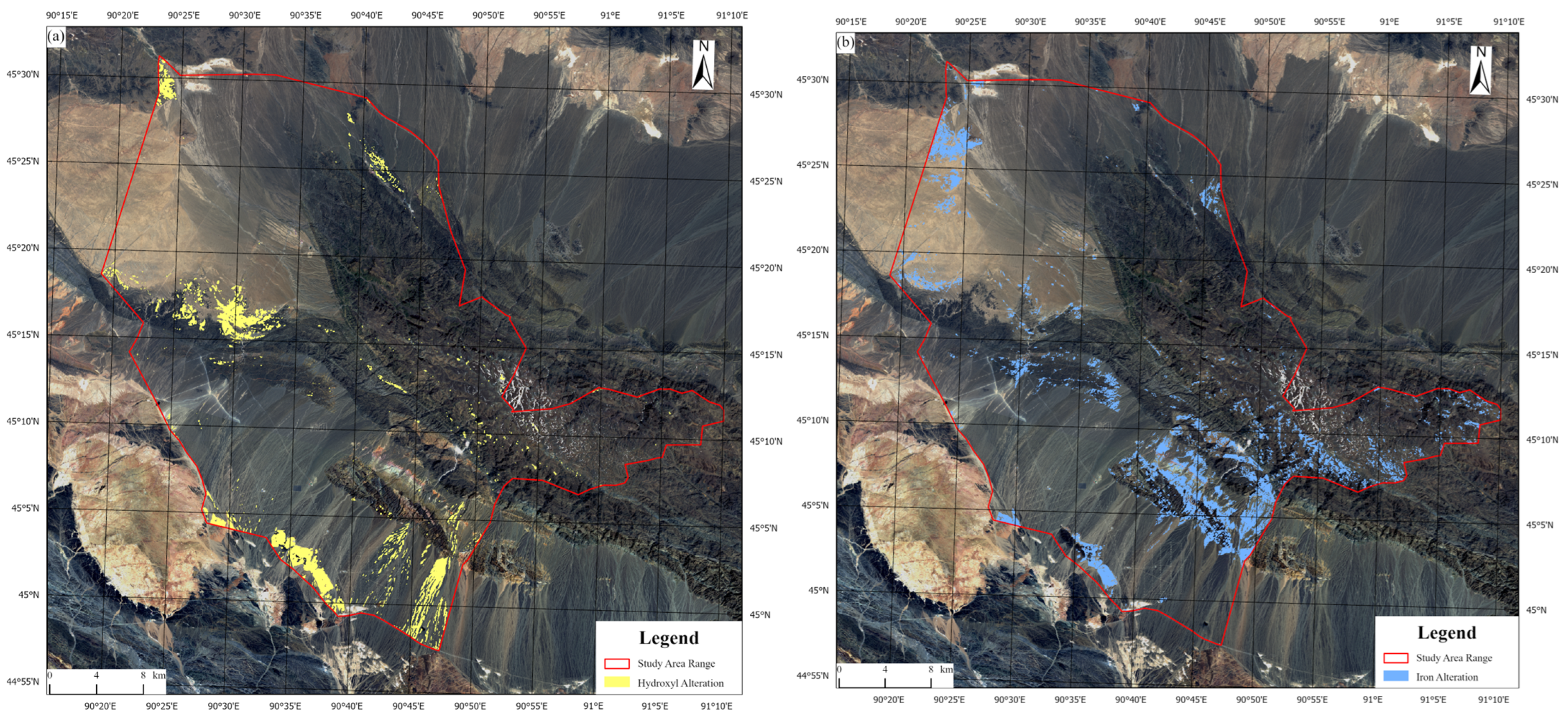
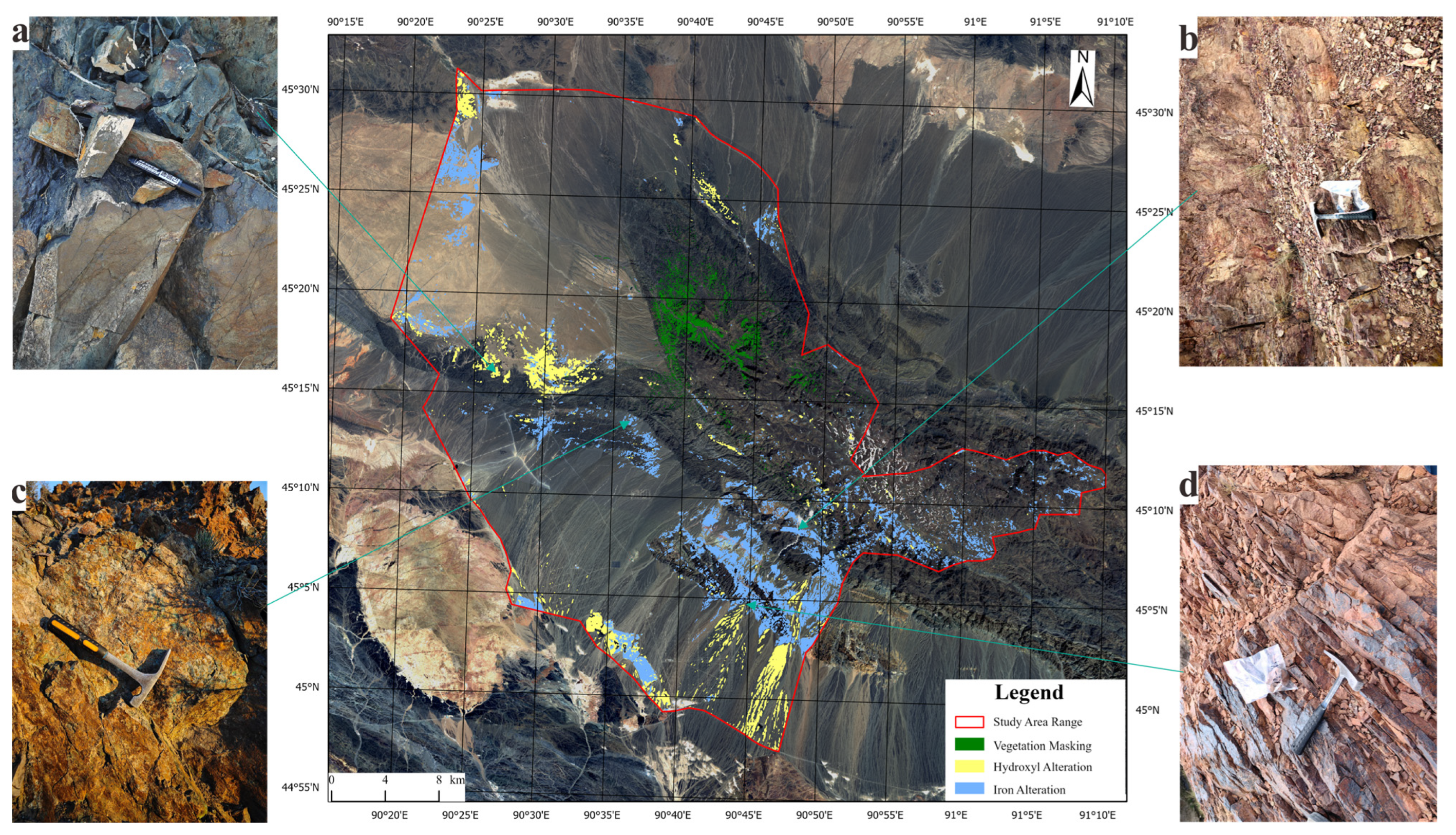

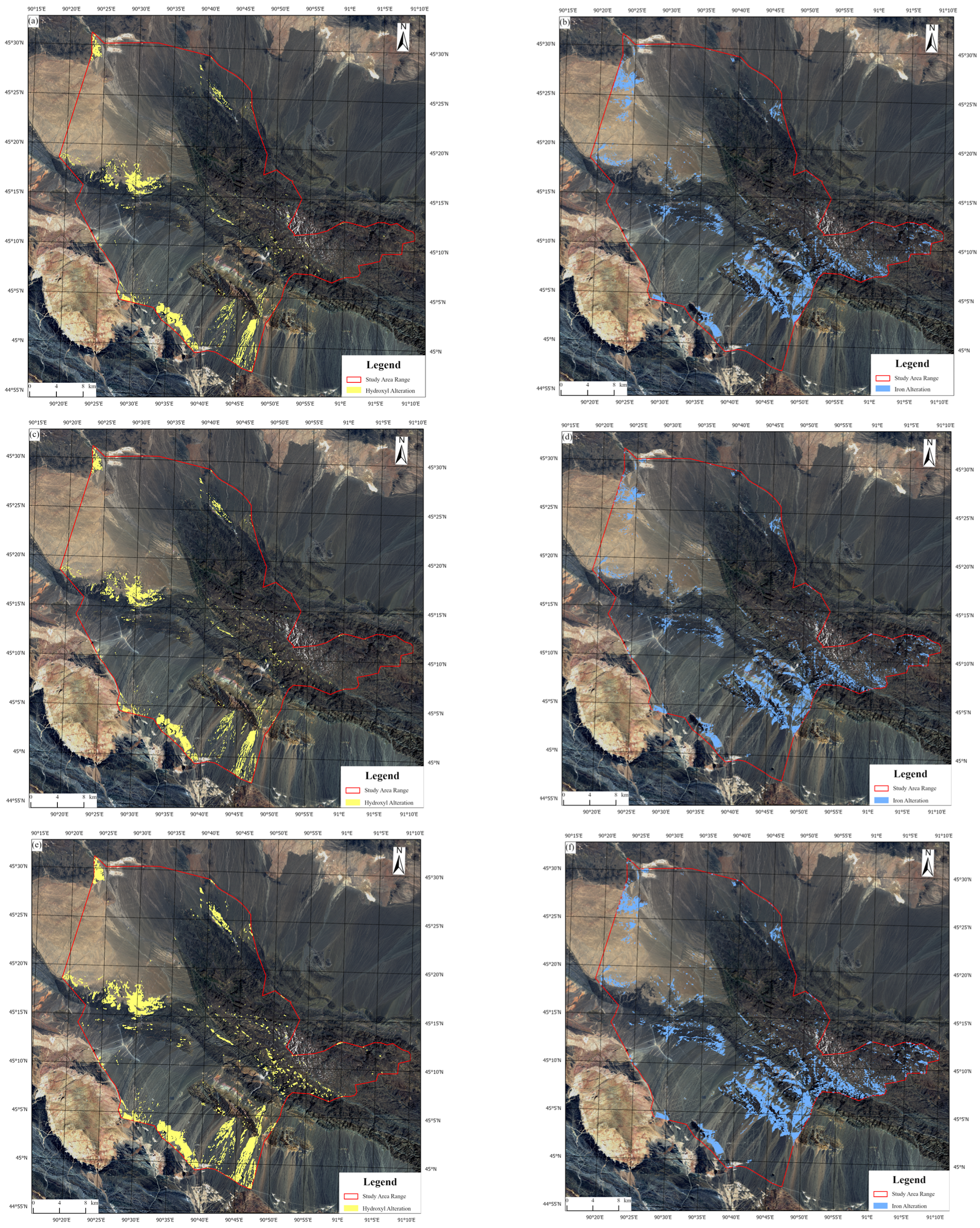
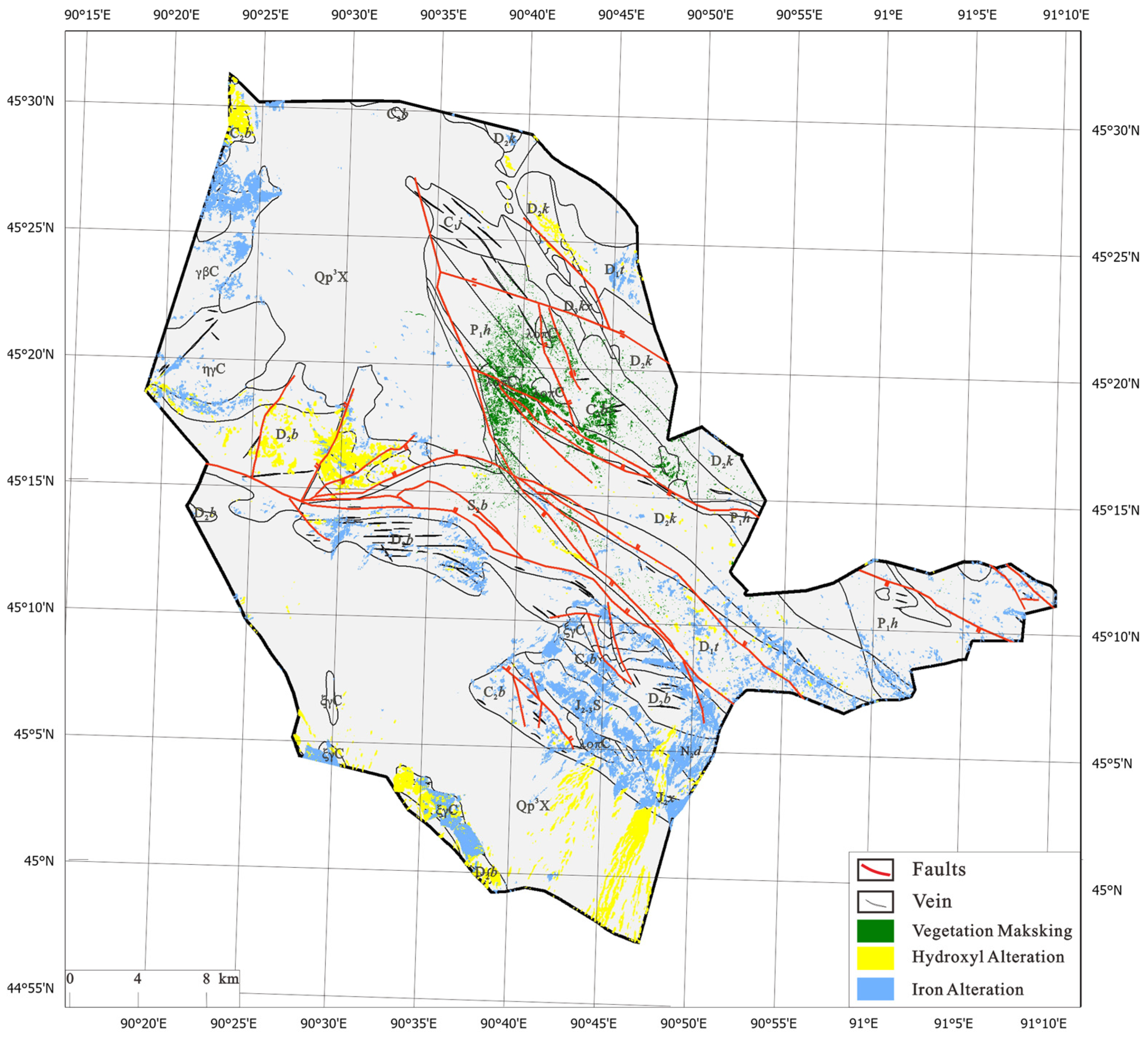
| Class Label | Assessment | RAHC-AIE | 2D-CNN | SVM |
|---|---|---|---|---|
| Hydroxyl Alteration | PA | 98.61 ± 0.51 | 92.35 ± 1.05 | 90.00 ± 1.12 |
| MPA | 90.41 ± 1.12 | 89.21 ± 1.03 | 90.05 ± 1.15 | |
| kappa | 98.16 ± 0.32 | 95.15 ± 1.12 | 96.01 ± 1.32 | |
| Mean_F1 | 93.00 ± 0.89 | 93.12 ± 0.84 | 92.07 ± 1.05 | |
| FWIoU | 97.03 ± 0.45 | 96.06 ± 0.32 | 95.04 ± 0.81 | |
| Iron Alteration | PA | 96.45 ± 0.78 | 94.45 ± 0.68 | 95.46 ± 0.49 |
| MPA | 91.92 ± 0.95 | 89.95 ± 0.95 | 89.94 ± 0.94 | |
| kappa | 95.28 ± 0.67 | 92.56 ± 0.46 | 92.74 ± 0.32 | |
| Mean_F1 | 92.25 ± 0.82 | 90.04 ± 1.23 | 91.25 ± 1.02 | |
| FWIoU | 93.40 ± 0.91 | 93.39 ± 0.95 | 91.23 ± 0.95 |
| Class Lable | Assessment | RAHC-AIE | RAHC-AIE without CBAM | RAHC-AIE without Residual Attention |
|---|---|---|---|---|
| Hydroxyl Alteration | PA | 98.61 ± 0.51 | 98.35 ± 0.42 | 94.16 ± 0.31 |
| MPA | 90.41 ± 1.12 | 93.17 ± 1.15 | 96.89 ± 1.25 | |
| kappa | 98.16 ± 0.32 | 97.74 ± 0.23 | 64.39 ± 0.36 | |
| Mean_F1 | 93.00 ± 0.89 | 92.00 ± 0.87 | 81.00 ± 0.72 | |
| FWIoU | 97.03 ± 0.45 | 96.96 ± 0.36 | 91.32 ± 0.23 | |
| Iron Alteration | PA | 96.45 ± 0.78 | 96.41 ± 0.63 | 93.21 ± 0.65 |
| MPA | 91.92 ± 0.95 | 91.71 ± 0.58 | 95.09 ± 1.02 | |
| kappa | 95.28 ± 0.67 | 95.26 ± 0.36 | 75.01 ± 0.53 | |
| Mean_F1 | 92.25 ± 0.82 | 92.00 ± 0.65 | 87.50 ± 0.98 | |
| FWIoU | 93.40 ± 0.91 | 93.32 ± 0.32 | 88.71 ± 0.32 |
Disclaimer/Publisher’s Note: The statements, opinions and data contained in all publications are solely those of the individual author(s) and contributor(s) and not of MDPI and/or the editor(s). MDPI and/or the editor(s) disclaim responsibility for any injury to people or property resulting from any ideas, methods, instructions or products referred to in the content. |
© 2025 by the authors. Licensee MDPI, Basel, Switzerland. This article is an open access article distributed under the terms and conditions of the Creative Commons Attribution (CC BY) license (https://creativecommons.org/licenses/by/4.0/).
Share and Cite
Wang, W.; Yalikun, Y.; Chen, M.; Wumaier, A.; Tuniyazi, Y. Mineralization Alteration Extraction Based on Residual Attention and Hybrid Convolution. Minerals 2025, 15, 510. https://doi.org/10.3390/min15050510
Wang W, Yalikun Y, Chen M, Wumaier A, Tuniyazi Y. Mineralization Alteration Extraction Based on Residual Attention and Hybrid Convolution. Minerals. 2025; 15(5):510. https://doi.org/10.3390/min15050510
Chicago/Turabian StyleWang, Wei, Yaxiaer Yalikun, Ming Chen, Amina Wumaier, and Yilihamujiang Tuniyazi. 2025. "Mineralization Alteration Extraction Based on Residual Attention and Hybrid Convolution" Minerals 15, no. 5: 510. https://doi.org/10.3390/min15050510
APA StyleWang, W., Yalikun, Y., Chen, M., Wumaier, A., & Tuniyazi, Y. (2025). Mineralization Alteration Extraction Based on Residual Attention and Hybrid Convolution. Minerals, 15(5), 510. https://doi.org/10.3390/min15050510






